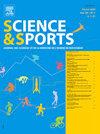Effects of eccentric cycling training on the physical performance of patients with chronic obstructive pulmonary disease: A systematic review of randomized clinical trials
IF 0.8
4区 医学
Q4 SPORT SCIENCES
引用次数: 0
Abstract
Introduction
Physical exercise represents a common strategy for addressing deficits in endurance and muscle strength in patients with chronic obstructive pulmonary disease (COPD). However, during exercise, COPD patients often experience exacerbations of dyspnea and hypoxia, which hinder their tolerance to therapeutic exercise programs. To address this challenge, studies have been conducted employing eccentric cycling training as a therapeutic program for COPD patients.
Objective
To determine the effects of eccentric cycling training on the physical performance of COPD patients through a systematic review of randomized clinical trials.
Methods
A search for randomized clinical trials was conducted on PubMed, Bireme, Scopus, and Web of Science with a deadline of February 3, 2024, following PRISMA guidelines. The CONSORT checklist and the clinical trial checklist provided by SIGN were used to assess quality. Additionally, the ROB 2 tool was employed to determine the risk of bias in the included studies.
Results
Initially, 758 articles were identified, of which, after a selection process carried out independently by two reviewers, 4 studies were selected, allowing for the analysis of 59 COPD patients, aged between 51 and 86 years. The quality of these studies was deemed acceptable, although two of them exhibited a high risk of bias, one showed a low risk of bias, and one raised some concerns. It was evidenced that eccentric cycling could improve performance in the 6-minute walk test (P < 0.05), whereas concentric cycling did not show significant improvements (P ≥ 0.05). Additionally, improvements in isometric and isokinetic strength of the quadriceps muscles were observed following participation in eccentric cycling training (P < 0.05).
Conclusions
Eccentric cycling training has the potential to improve isometric and isokinetic quadriceps muscle strength, as well as functional performance measured by the 6-minute walk test in patients with COPD. However, it does not appear to significantly impact aerobic capacity. Further studies with comparable designs are needed to strengthen the evidence and confirm these findings.
Introduction
L’exercice physique représente une stratégie courante pour traiter les déficits d’endurance et de force musculaire chez les patients atteints de bronchopneumopathie chronique obstructive (BPCO). Cependant, pendant l’exercice, les patients atteints de BPCO éprouvent souvent des exacerbations de la dyspnée et de l’hypoxie, ce qui entrave leur tolérance aux programmes d’exercice thérapeutique. Pour relever ce défi, des études ont été menées en utilisant l’entraînement par cyclisme excentrique comme programme thérapeutique pour les patients atteints de BPCO.
Objectif
Déterminer les effets de l’entraînement par cyclisme excentrique sur la performance physique des patients atteints de BPCO à travers une revue systématique des essais cliniques randomisés.
Méthodes
Une recherche d’essais cliniques randomisés a été effectuée sur PubMed, Bireme, Scopus et Web of Science jusqu’au 3 février 2024, conformément aux directives PRISMA. La checklist CONSORT et la checklist des essais cliniques fournie par SIGN ont été utilisées pour évaluer la qualité. De plus, l’outil ROB 2 a été employé pour déterminer le risque de biais dans les études incluses.
Résultats
Initialement, 758 articles ont été identifiés, dont, après un processus de sélection effectué indépendamment par deux réviseurs, 4 études ont été sélectionnées, permettant l’analyse de 59 patients atteints de BPCO, âgés de 51 à 86 ans. La qualité de ces études a été jugée acceptable, bien que deux d’entre elles aient présenté un risque élevé de biais, une ait montré un faible risque de biais et une ait soulevé quelques préoccupations. Il a été démontré que le cyclisme excentrique pouvait améliorer la performance au test de marche de 6 minutes (p < 0,05), tandis que le cyclisme concentrique n’a pas montré d’améliorations significatives (p ≥ 0,05). De plus, des améliorations de la force isométrique et isocinétique des muscles quadriceps ont été observées après la participation à un entraînement par cyclisme excentrique (p < 0,05).
Conclusions
L’entraînement à vélo excentrique semble avoir le potentiel d’améliorer la force musculaire isométrique et isocinétique des quadriceps, ainsi que la performance fonctionnelle mesurée par le test de marche de 6 minutes chez les patients atteints de BPCO. Cependant, il ne semble pas avoir d’impact significatif sur la capacité aérobie. Des études supplémentaires avec des conceptions comparables sont nécessaires pour renforcer les preuves et confirmer ces résultats.
偏心单车训练对慢性阻塞性肺疾病患者体能表现的影响:随机临床试验的系统综述
导言体育锻炼是解决慢性阻塞性肺病(COPD)患者耐力和肌肉力量不足问题的常用策略。然而,在运动过程中,慢性阻塞性肺病患者经常会出现呼吸困难和缺氧加重的情况,这阻碍了他们对治疗性运动计划的耐受性。为了应对这一挑战,已有研究采用偏心骑行训练作为慢性阻塞性肺病患者的治疗方案。目的 通过对随机临床试验进行系统回顾,确定偏心骑行训练对慢性阻塞性肺病患者身体表现的影响。方法 按照 PRISMA 指南,在 PubMed、Bireme、Scopus 和 Web of Science 上搜索随机临床试验,截止日期为 2024 年 2 月 3 日。评估质量时使用了 CONSORT 核对表和 SIGN 提供的临床试验核对表。此外,还采用了 ROB 2 工具来确定所纳入研究的偏倚风险。结果最初共确定了 758 篇文章,经过两名审稿人独立进行的筛选过程后,从中选出了 4 项研究,对 59 名慢性阻塞性肺病患者进行了分析,这些患者的年龄在 51 岁至 86 岁之间。这些研究的质量被认为是可以接受的,尽管其中有两项研究显示出较高的偏倚风险,一项研究显示出较低的偏倚风险,还有一项研究引起了一些关注。有证据表明,偏心骑行可提高 6 分钟步行测试的成绩(P <0.05),而同心骑行则无明显改善(P ≥ 0.05)。结论偏心骑行训练具有改善 COPD 患者股四头肌等长和等动肌力以及 6 分钟步行测试功能表现的潜力。但是,它似乎不会对有氧能力产生显著影响。引言运动是治疗慢性阻塞性肺病(COPD)患者肌肉耐力和力量缺陷的常用策略。然而,在运动过程中,慢性阻塞性肺病患者往往会出现呼吸困难和缺氧加重的情况,从而影响他们对治疗性运动计划的耐受性。为了应对这一挑战,已有研究将偏心骑行训练作为慢性阻塞性肺病患者的治疗方案。目的 通过对随机临床试验进行系统回顾,确定偏心骑行训练对慢性阻塞性肺病患者体能表现的影响。方法 根据 PRISMA 指南,在 PubMed、Bireme、Scopus 和 Web of Science 上搜索截至 2024 年 2 月 3 日的随机临床试验。采用 CONSORT 核对表和 SIGN 提供的临床试验核对表进行质量评估。此外,还使用了 ROB 2 工具来确定纳入研究的偏倚风险。结果最初共确定了 758 篇文章,经过两名审稿人独立进行筛选后,从中选出了 4 项研究,对 59 名慢性阻塞性肺病患者进行了分析,这些患者的年龄在 51 岁至 86 岁之间。这些研究的质量被认为是可以接受的,但其中有两篇研究显示偏倚风险较高,一篇研究显示偏倚风险较低,还有一篇研究引起了一些关注。研究结果表明,偏心骑行能够提高 6 分钟步行测试的成绩(p < 0.05),而同心骑行则没有明显改善(p ≥ 0.05)。结论偏心骑行训练似乎有可能改善慢性阻塞性肺病患者的等长和等动股四头肌肌力,以及通过 6 分钟步行测试测量的功能表现。但是,它似乎对有氧能力没有显著影响。要加强证据并证实这些结果,还需要进行更多具有可比设计的研究。
本文章由计算机程序翻译,如有差异,请以英文原文为准。
求助全文
约1分钟内获得全文
求助全文
来源期刊

Science & Sports
社会科学-运动科学
CiteScore
1.50
自引率
18.20%
发文量
143
审稿时长
19.7 weeks
期刊介绍:
Science & Sports is a peer-reviewed journal, publishing worldwide high-quality and impactful papers of medical, scientific and applied technical research in the different fields of sports and physical activities: sport medicine, exercise physiology, sport physiology and performance, nutrition, traumatology relating to sport, rehabilitation or adapted physical activities. It facilitates the transfer of knowledge and technology between the clinic, research and practice in physical and athletic activity.
 求助内容:
求助内容: 应助结果提醒方式:
应助结果提醒方式:


